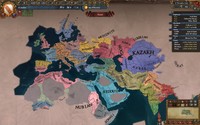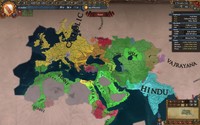Part 33: World of 1444
Chapter 1 – World of 1444
Empires have risen and fallen on the whim of the wind, plague and invasions have decided the fates of entire kingdoms, alliances have been wrought and wars waged in the name of God and profit…
From Iberia to Cathay, the Middle Ages have proven to be rocky and unstable, a deadly game where the strongest prosper and the rest are left to die, leaving the world of 1444 vastly different from what it was 400 years prior.
Starting with Iberia, the Jizrunids have managed to reunify Al Andalus and drag it out of the Old Taifa period, but civil wars have prevented them from expanding much more that that. It still falls short of the Umayyad Caliphate of old, but with the wise and enlightened Majlis leading the sultanate, what’s the worse that could happen?

Christian Europe has seen the balance of power shifted as well. The fiercely-rivaled Kingdoms of England and France dominate the landscape, but both have dangerous rivals in the Celtic Empire and Bavaria, whose king is also Holy Roman Emperor. Meanwhile, to the south the Kingdom of Italy is also on the rise, and is determined to bring the entire Italian peninsula under its rule.

Next, the Balkans are divided into more than a dozen feuding states, successors to the once-great Byzantine Empire after it’s destruction at the hands of the Latin Empire. The race as to who can now unify Greece and reclaim Constantinople is on, and the immediate future of the region is sure to be bloody.

Meanwhile, to the north, the eternal struggle between the Russians and the Mongols continue. The Russians are divided into Orthodox and Bogomilist camps, however, creating bitter rivalries and weakening them before the Mongol onslaught.

In the Near East, the legacy of the Crusades lives on in Egypt, the last of the Crusader states. The Jizrunid Sultanate of Filastin threatens its dominance, however, with Sultan Khudayr vowing to eliminate any Christian presence in the Middle East.
To the immediate north, a similar struggle has erupted between the Byzantine successor state of Nicaea and the self-proclaimed caliphate of Armenia. The victor of their inevitable wars will decide whether Anatolia is to be Muslim or Christian, Sunni or Iconoclast.

Finally, the rich subcontinent of India is carved between several Hindu kingdoms, the most powerful of which is Delhi, though Rajputana is not far behind. In Afghanistan, meanwhile, the Sunni holy state of Ghazi is preparing an invasion of Punjab, bent on spreading Islam by the sword.

Back in Al Andalus, however, there are matters demanding immediate attention. Firstly, the Sultan is currently the twelve-year-old Utman II, a fool that can’t tell one end of a sword from the other. To make matters worse, he is also a known craven, greatly damaging the morale of his subjects.

Because Utman doesn’t have the capacity to rule, the Sultanate is currently under the firm control of the Majlis, who’ve spent the past four years ensuring that Al Andalus remains at peace.

On the diplomatic front, the kingdoms of Aragon, France and England have all publicly declared Al Andalus as their rivals. France have also named themselves the protectors of Aragon, and the duo seem poised to begin a renewed crusade for Iberia.

Economically, the Sultanate is operating on a net monthly income of 3.7 dinars, the majority of which comes from taxation, though domestic trade and local gold mines certainly help.

The Ulama, the religious and scholarly body in Al Andalus, hold considerable sway in the Majlis. Thus, it is unsurprising that there are few calls for more tolerance for heathens or heretics, though this can certainly change in the future.

As for the paths currently open to the Sultanate, the choices are numerous and varied, with some calling for war with the Christians, others for improved relations with nearby Muslim states, and others still demanding a focus on peace and trade.

And finally, being the most important tools of any kingdom, the army is in solid shape. The standing army currently numbers 21000, 16000 of which are infantry, whilst the rest are cavalry. It has seen little action in recent years, however, so its discipline and army tradition is nothing to crow about.
The navy, on the other hand, has seen significant expansion over the past four years. Where Al Andalus only had a few transport vessels before, its navy now boasts an impressive five capital ships, eight barques and 14 transports.

The Middle Ages have undoubtedly proven to be a chaotic period, rife with tyrannical kings and despots, beset with destructive crusades and jihad, plagued with ruinous civil wars and rebellion.
Al Andalus has emerged from it as a great power in its own right, however, and the world around it is fast changing. The feudal ties linking king and vassal are quickly giving way more centralised forms of government, the rediscovery of classical philosophy is sparking a cultural movement across Europe, entire worlds are waiting to be explored and conquered by those willing to take the risks…
A new age is certainly dawning, an age of exploration and discovery, an age of reformation and advancement, an age of global war and revolution.

The world of 1444, with most altered countries labeled (open it a new tab to actually see it):

Culture map:

Religious map:
